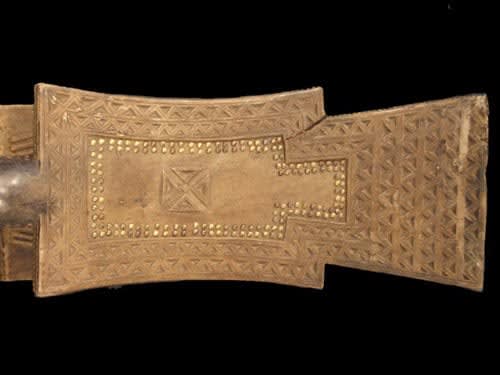Chokwe Wooden Stool in the Form of a Vulture, 20th Century CE
Wood
50 x 16 x 13.5
LSO.254
Most African groups have social systems which are rigorously controlled and clearly flagged through the use of status symbols and socially significant regalia. Tchokwe rulers (mwanangana) are entitled to employ...
Most African groups have social systems which are rigorously controlled and clearly flagged through the use of status symbols and socially significant regalia. Tchokwe rulers (mwanangana) are entitled to employ specialist craftsmen whose job it is to produce high-quality evidence of conspicuous consumption, far outranking in terms of opulence anything that could be produced by semi-professional songi and fuli craftsmen. Courtiers and what in western terms might be considered to be the prosperous middle classes made their aspirations known through the commissioning and ownership of luxury goods such as this. Once western influence reached the Tchokwe, the traditional format of stools – which have always been associated with high social status – gave way to a more westernised chair style, although these would also be decorated with indigenous motifs. The current example is more traditional and probably older than these later innovations. Carved from a single piece of wood, this stool is made in the form of a large, ornate bird, with the body forming the seat. It stands on an integral base on stocky legs, and the stool surface sweeps upwards distally so that the “tail” is the most elevated part of the seat. Both the legs and the body/tail are decorated with geometric motifs based around triangles. These demarcate a plain area in the centre of the stool (the bird's back) that is ringed with brass studs and finished with a cruciform design that is often found on Tchokwe works. Anteriorly, the bird’s neck extends downwards and then rears up to form the head. The neck is plain with some stud decoration. The head resembles that of a raptor, with a hooked beak and a large ovoid eye that is decorated with a brass stud. The general proportions of the cranial complex suggest that it was based upon a vulture. The stool is finished with a necklace of cloth and Congolese coins (dating from the 1920s), another of white beads and seeds, and a third of black and white animal fur with two marine shells (a cowrie and conch – probably from the Indian Ocean). The bird is gripping a large, threaded seed pod on a string in its beak. The Tchokwe are known for producing highly decorated utilitarian and status objects, including bed-like stools that are clearly designed for social elites. This remarkable object would seem to belong in that category.
